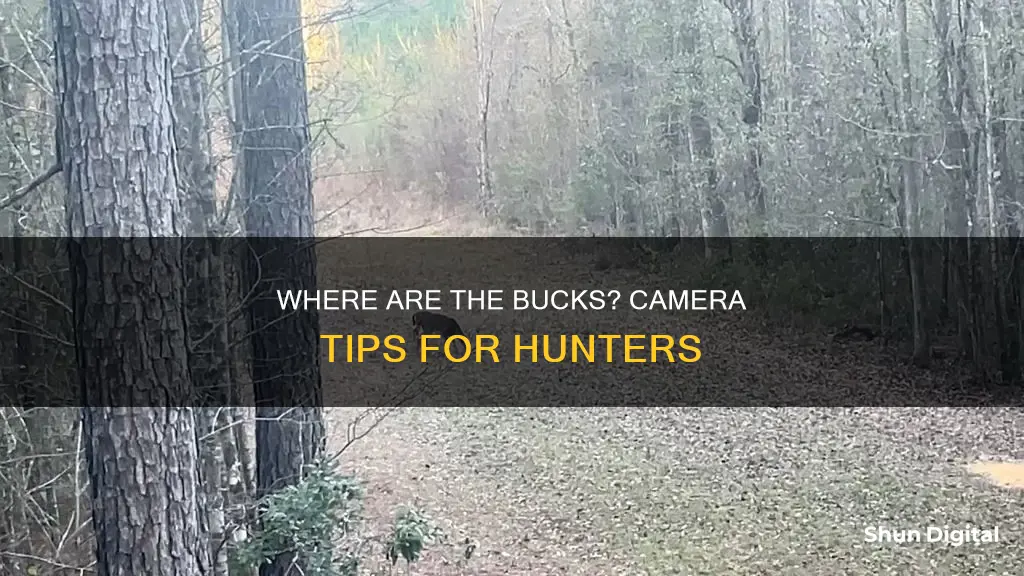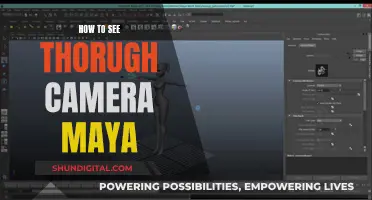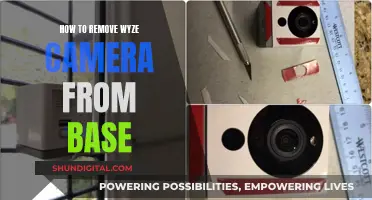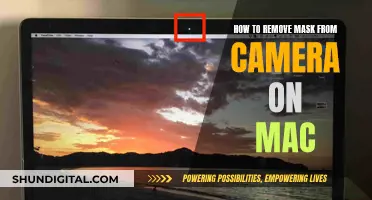
There are many reasons why you might not be seeing bucks on camera. One of the more common reasons is hunting pressure, as bucks are very loyal to their primary beds and will only tolerate so much human presence. Bucks also tend to move less and cover less ground in the summer, contracting their movements into smaller ranges. Food source changes can also cause bucks to disappear from camera as they switch from soybeans to acorns and woody browse. Another reason could be that the camera setup is incorrect, with cameras placed in voids between smaller summer ranges. Human intrusion, such as scent, noise, or a lack of predator control, can also push bucks to another area.
| Characteristics | Values |
|---|---|
| Human intrusion | Too much human presence and noise can push bucks to another area. |
| Scent | Hunters might forget to scent down on their way to check cameras. |
| Camera setup | Cameras might not be in the right spots, or there might not be enough of them. |
| Food source | Deer switch from soybeans in summer to acorns and woody browse in fall. |
| Time | It might be too early in the season to see bucks on camera. |
| Hunting pressure | Too much hunting pressure can cause bucks to move less during the day and spend more time in thick cover. |
| Predators | A steady presence of predators can push bucks to another area. |
| Bully buck | A dominant buck in the area might be pushing all the other bucks out. |
| Death | The buck might have died from a predator, a car, or an illness. |
What You'll Learn

Bucks may have moved to a different food source
If you're not seeing bucks on camera, it could be because they've moved to a different food source. Bucks go through many food source changes throughout the year, and one of the biggest changes happens right before the hunting season starts. During the summer, they feed on soybeans and other summer forages like alfalfa in Ag fields. However, as October approaches, they tend to switch to acorns and woody browse. This means that your buck is likely still within a few hundred yards of his summer range but has simply found another food source.
To confirm this, you could try changing your trail camera locations to see if you can hone back in on the buck in different areas. You could also try moving your trail cameras around the property or scouting a different area or public land. Remember that a buck's summer home range can differ significantly from his fall and winter range.
If you own or have permission to hunt on private land, you could also consider implementing deer management strategies and habitat management plans to improve the habitat on your property. This might involve consulting a private land biologist to determine any limiting factors, such as a lack of bedding cover, food, or security, and making the necessary improvements.
Sharp Roku TV: Built-In Cameras or Not?
You may want to see also

Human intrusion may have pushed bucks to another area
Human intrusion can include a range of factors, from scent to noise. When checking cameras, be sure to scent down and remain quiet. It is also important to be mindful of the time of day when checking cameras, especially if this is during the evening when bucks are more likely to be present.
If you have forgotten to scent down or have been overly loud, give the area time to rest and continue to monitor your cameras. Bucks may reappear in the early fall.
In addition to human intrusion, the time of year may also be a factor. During the summer, bucks tend to contract their movements and cover less ground. They may be less active and more reclusive, especially in heavy woodlands with little or no agriculture or obvious food sources.
It is also worth considering other factors, such as food sources and habitat changes. Bucks go through many food source changes throughout the year, and one of the biggest changes happens right before the hunting season. They may have switched from soybeans in ag fields to acorns and woody browse. Additionally, a buck may simply spend his fall in a different area than his summer range.
To increase your chances of capturing bucks on camera, consider moving your trail camera locations to different areas, especially near food sources and bedding areas. You can also try combining a regular trail camera setup over a deer run with a mock scrape to create a point of attraction and increase traffic.
Apple Watch Series 3: GPS and Camera Features Explored
You may want to see also

Predators may be scaring the bucks away
Deer are easily spooked by the presence of predators, and this could be a reason why you are not seeing bucks on your camera. While coyotes, wolves, and cougars are all predators that can scare deer, the one they fear the most is the human "super predator".
A 2018 study by Dr. Daniel Crawford found that deer were nearly twice as likely to run from human recordings than those of any other predator. The sound of conversational human voices was overwhelmingly the most fear-inducing. This is likely because deer associate human voices with hunting, the most efficient method of deer predation.
Human pressure can also reduce deer feeding time, impacting their health and population numbers. Deer are cautious and can be scared off by the scent of humans, loud noises, or even the sight of a human. They become mature by being overly cautious, and if they smell or spot you, they will likely relocate.
Therefore, if you are not seeing bucks on camera, it may be because they are being scared away by the presence of human predators. To improve your chances of capturing bucks on camera, try to minimise your impact on the area. Stay as concealed and scent-free as possible, and minimise foot traffic, especially during hunting seasons.
Casting Camera Feeds: Using Chromecast to View Live Footage
You may want to see also

The camera setup may need adjusting
If you're not seeing bucks on camera, it could be that your camera setup needs adjusting. Here are some tips to improve your setup:
- Rethink your camera placement: Try to find locations where deer will be travelling through, based on the overall appearance and signs that may be present. Consider moving your cameras around and trying new tactics. Make sure you are getting reasonable coverage of the property, and if possible, run multiple trail cameras to help narrow down any potential areas you may have overlooked.
- Combine a regular trail camera setup with a mock scrape: By creating a point of attraction, you can increase the traffic on the run and encourage bucks to stop for a more detailed picture.
- Change trail camera locations: Bucks may have moved away from their summer ranges to enjoy different food sources. Try to identify these new food sources and adjust your camera locations accordingly.
- Minimize human intrusion: Bucks can be easily spooked by human presence, so be cautious when checking your cameras. Avoid leaving your scent or making loud noises, especially during evening hours. Give the area time to rest and continue monitoring your cameras remotely if possible.
- Practice good predator control: A steady presence of predators can push bucks to another area. Trapping is a fun and effective way to eliminate predators and create a safer environment for bucks.
- Try different attractants: In addition to food sources, you can use mineral blocks, corn, or apples to attract bucks to your camera locations.
- Give it time: Don't be too quick to move your cameras. Allow sufficient time for bucks to discover and become comfortable with your attractants. Checking your cameras too frequently can also increase the risk of spooking the bucks.
Viewing Your Camera Feed on Echo Show: A Guide
You may want to see also

The buck may have died
While it is unlikely that the buck has died, it is a possibility. Nature is unpredictable, and sometimes animals do die. They could have been killed by a predator, or they could have fallen victim to a car accident or illness. If you are unable to locate a particular buck, it is possible that nature claimed it before you could.
If you are unable to capture any images of bucks on your trail camera, it could be due to several factors. One reason could be that the bucks have relocated to a different area. During the summer, bucks tend to have smaller home ranges and core areas, which increase during the fall and winter. If your camera is placed outside of their summer core area, you may not capture any images of them. Additionally, bucks tend to change their food sources and patterns as the seasons shift. For example, they may switch from feeding on soybeans in ag fields during the summer to acorns and woody browse in the fall. This change in diet could lead them to relocate a few hundred yards away from their previous range.
Human intrusion is another factor that can drive bucks away. Bucks are cautious and loyal to their primary beds. If they sense human presence or hunting pressure in their core areas, they may relocate to less disturbed areas. This is especially true for mature bucks, who tend to move less during daylight and spend more time in thick cover to avoid detection.
To improve your chances of capturing bucks on camera, consider the following strategies:
- Move your trail cameras to new areas, especially those with food sources such as soybeans, alfalfa, or acorns.
- Reduce human intrusion and hunting pressure in the area by practising scent control and limiting the frequency of camera checks.
- Try using different attractants, such as mineral blocks, corn, or apples, to lure bucks in front of the camera.
- Be patient and give the bucks time to adjust to any changes in their environment.
Pentax Camera Identification: A Guide to Knowing Your Model
You may want to see also
Frequently asked questions
Bucks may be avoiding an area with a lot of human presence. They are very loyal to their primary beds and will only tolerate so much human intrusion.
Try to limit the time spent within the core area. If you are checking trail cameras, do so sparingly and be mindful of your scent and noise.
Yes, bucks move less in the summer than in any other season. They also tend to change their food sources and locations as the season transitions to fall.
Try moving your trail camera locations to hone in on the buck in different areas.
Yes, try placing your trail cameras around food plots and bedding areas. Also, be mindful of the time of day and avoid white flash cameras, as these can spook deer.







